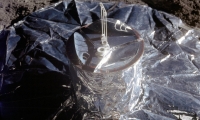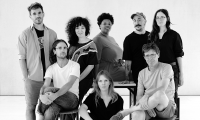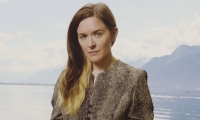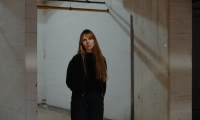WORKS
Alvin Lucier: Love Song
Maria W Horn: Crystal Shades of Sorrow
Alvin Lucier: Wind Shadows
Laure M. Hiendl: Chronochromatic Variations I
Aisha Orazbayeva: Open for Feedback
Maria W Horn: Time Variables
James Tenney: Having Never Written A Note For Percussion
Maria W Horn: All Solids Melt Into Aether
CAST
Concept & direction: Aïda Gabriels
Created with and performed by Nabou Claerhout, Geert De Bièvre, Victor Guaita, Maria W. Horn, Aisha Orabayeva, Ruben Orio, Matteo Sedda
Dramaturgy: Tom Pauwels
Light: Astrid Van Steenkiste
Sound: Vincent Bongnie
Scenography: Astrid Van Steenkiste, Tanja Mala Ngombe & Noir Métal (Pans, 2022, Modular steel structure. Work produced as part of the exhibition presented at La Verrière by Fondation d’entreprise Hermès)
Scenographic advice: Milan Hendrickx
Choreographic advice: Matteo Sedda
Production management: Ruth Sarens & Anita Cappuccinelli
Nabou Claerhout: trombone
Geert De Bièvre: cello
Victor Guaita: viola
Maria W Horn: organ, keyboards
Aisha Orazbayeva: violin
Rubén Orio: percussion
Matteo Sedda: movement
PRODUCTION
Production: B-Classic
Co-production: Ictus, Oester, Botanique, Concertgebouw Brugge & Per Podium
This production was made possible with the support of the Flemish Community
and with the support of the Tax Shelter measure of the Belgian Federal Government
With thanks to Needcompany
Stage director Aïda Gabriels invites Ictus ensemble, one dancer and composer-organist Maria W Horn for a long performance in which the audience is immersed in a flow of sound, visual art, light, and movement. The slowness, the ritualization of the concert, and the gradual invasion of the entire sound space by an atypical quintet (string trio, trombone and analog synthesizers) create what Maria W Horn calls “aural monoliths”. In a similar way, to Aïda Gabriels music only reveals its deepest impact when it is considered as an art in space rather than an art in time. From that point on, anything can happen. Slowness does not mean beatitude. The exploration of the grain of sound is not the harmony of the spheres. Danger lurks. The soundscape gradually reveals its cracks, its crumbling, its layered structure, and its seminally seismic nature: once we pass certain thresholds, we enter a zone of high turbulence.
Aïda Gabriels:
"... a performance that draws the audience into a continuous flow of sound, light, movement, and spatial tension. Here, sound behaves like matter under pressure, seismic, shifting, alive."
Klaas Coulembier, "De Toonbank" for Concertgebouw Brugge
“SEISMIC shifts the way we look at the world. It lets go of the traditions and rituals of the concert format, searching for a new way of engaging with music. This is not a concert, but a total environment where scenography, choreography, and music form a unified whole. As a spectator, you leave the safe anonymity of the concert hall seat behind. You become part of the space and decide where and how to connect with the soundscape, which is constantly in motion.”
Regisseuse Aïda Gabriels nodigt het Ictus ensemble, een danser en componist-organist Maria W Horn uit voor een lange voorstelling waarin het publiek wordt ondergedompeld in een flow vol geluid, beeldende kunst, licht en beweging. De traagheid, de ritualisering van het concert en de geleidelijke invasie van de hele geluidsruimte door een atypische formatie (strijktrio, trombone, percussie en analoge synthesizers) creëren wat Maria W Horn ‘auditieve monolieten’ noemt. Op dezelfde manier laat de muziek zijn diepste impact pas zien voor Aïda Gabriels wanneer deze als een kunst in de ruimte in plaats van een kunst in de tijd wordt beschouwd. Vanaf dat moment kan alles gebeuren. Traagheid staat niet gelijk aan gelukzaligheid. Het opgaan in de korrel van de klank is iets anders dan het opstijgen in de de harmonie van de sferen. Er schuilt overal gevaar. Er verschijnen barsten in het muzikaal panorama. Het brokkelt af, het is gelaagd en het is in de kiem seismisch van aard. Zodra we bepaalde drempels overschrijden, komen we in een bijzonder turbulente zone terecht.
Aïda Gabriels:
"De concertzaal zelf wordt een veld van transformatie waarin klank, licht en lichaam zich vervormen tot één pulserende materie. Het publiek wordt niet slechts toeschouwer, maar bewoner van een ecosysteem in voortdurende flux."
Klaas Coulembier, "De Toonbank" voor Concertgebouw Brugge
Dat is waar Seismic mee speelt: onze gebruikelijke kijk op de wereld in beweging brengen, de tradities en rituelen van ‘het concert’ loslaten en op zoek gaan naar een nieuw contact met de muziek. De voorstelling Seismic is dan ook geen concert, maar eerder een totaalconcept waarin scenografie, choreografie en muziek een sterke eenheid vormen. (...) Als publiek verlaat je de veilige anonimiteit en passiviteit van het zitje in de concertzaal. Je wordt deel van de ruimte en bepaalt zelf waar en hoe je verbinding zoekt met de muziek.
La metteuse en scène Aïda Gabriels invite Ictus, un danseur et la compositrice-organisatrice Maria W Horn pour une longue performance où le public est plongé au cœur d'un flux de sons, d'art visuel, de mouvements et de lumières. La lenteur, la ritualisation du concert et l'invasion progressive de tout l'espace sonore par un quintette atypique (trio à cordes, trombone et synthétiseurs analogiques) créent ce que Maria W Horn appelle des « monolithes sonores ». Aïda Gabriels, dans le même esprit, suggère que la musique ne révèle son impact le plus profond que si on la considère comme un art de l'espace plutôt qu'un art du temps. Dès lors, tout peut arriver. La lenteur n'est pas la béatitude ! L'exploration du grain du son n'est pas l'harmonie des sphères ! Un danger guette. Le paysage sonore révèle peu à peu ses fissures, ses zones d'effondrement, sa structure en strates, son caractère sismique : passés certains seuils, nous entrons en zone de haute turbulence.
Aïda Gabriels : « ... une performance qui invite le public dans un flux continu de sons, de lumières, de mouvements et de tensions spatiales. Ici, le son se comporte comme une matière sous pression, sismique, changeante et organique. »
Klaas Coulembier, « De Toonbank » pour le Concertgebouw Brugge :
« SEISMIC change notre façon de voir le monde. Il abandonne les traditions et les rituels du format de concert pour rechercher une nouvelle façon d'aborder la musique. Ce n'est pas un concert, mais un environnement total où scénographie, mouvement et musique forment un tout. (...) En tant que spectateur, vous quittez l'anonymat rassurant de votre siège dans la salle de concert. Vous faites partie intégrante de l'espace et décidez où et comment vous connecter à l'environnement sonore, qui est en constante évolution. »
Agenda for this project
- Date Show Location
-
Sat 25.10 Seismic Botanique - Brussels - Belgium

- Date Show Location
-
Fri 07.11 Seismic Concertgebouw - Brugge - Belgium




